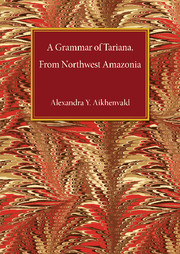Book contents
- Frontmatter
- Dedication
- Contents
- List of tables, schemes and diagrams
- Preface
- Acknowledgements
- Organisation and cross-referencing
- List of abbreviations
- Map
- 1 The language and its speakers
- 2 Phonology
- 3 Word classes
- 4 Nominal morphology and noun structure
- 5 Noun classes and classifiers
- 6 Possession
- 7 Case marking and grammatical relations
- 8 Number
- 9 Further nominal categories
- 10 Derivation and compounding
- 11 Closed word classes
- 12 Verb classes and predicate structure
- 13 Valency changing and argument rearranging mechanisms
- 14 Tense and evidentiality
- 15 Aspect, Aktionsart and degree
- 16 Mood and modality
- 17 Negation
- 18 Serial verb constructions and verb compounding
- 19 Complex predicates
- 20 Participles and nominalisations
- 21 Clause types and other syntactic issues
- 22 Subordinate clauses and clause linking
- 23 Relative clauses
- 24 Complement clauses
- 25 Discourse organisation
- 26 Issues in etymology and semantics
- Appendix. The main features of the Tariana dialects
- Texts
- Vocabulary
- References
- Index of authors, languages and subjects
21 - Clause types and other syntactic issues
Published online by Cambridge University Press: 05 August 2013
- Frontmatter
- Dedication
- Contents
- List of tables, schemes and diagrams
- Preface
- Acknowledgements
- Organisation and cross-referencing
- List of abbreviations
- Map
- 1 The language and its speakers
- 2 Phonology
- 3 Word classes
- 4 Nominal morphology and noun structure
- 5 Noun classes and classifiers
- 6 Possession
- 7 Case marking and grammatical relations
- 8 Number
- 9 Further nominal categories
- 10 Derivation and compounding
- 11 Closed word classes
- 12 Verb classes and predicate structure
- 13 Valency changing and argument rearranging mechanisms
- 14 Tense and evidentiality
- 15 Aspect, Aktionsart and degree
- 16 Mood and modality
- 17 Negation
- 18 Serial verb constructions and verb compounding
- 19 Complex predicates
- 20 Participles and nominalisations
- 21 Clause types and other syntactic issues
- 22 Subordinate clauses and clause linking
- 23 Relative clauses
- 24 Complement clauses
- 25 Discourse organisation
- 26 Issues in etymology and semantics
- Appendix. The main features of the Tariana dialects
- Texts
- Vocabulary
- References
- Index of authors, languages and subjects
Summary
This chapter considers a number of basic syntactic issues for Tariana, providing a background for Chapters 22-24 which deal with dependent clause types. We summarise the structure of noun phrases in §21.1. Coordination of noun phrases is discussed in §21.2. Then, in §21.3, we summarise the structure of predicates. Clause types are considered in §21.4. In §21.5 we discuss criteria for grammatical relations.
The structure of noun phrases
A noun phrase in Tariana consists of a head plus one or more modifiers. A noun, an adjective, or a member of one of the closed classes discussed in §§11.2-9 -demonstratives, specifier articles, quantifiers and deictics ~ can function as NP heads. A summary of the correlations between word classes and functional slots in a clause was given in Table 3.7. Table 11.1 contains a summary of which members of closed word classes can function as modifiers and which cannot.
The head of an NP triggers classifier or animacy agreement on its modifier(s) (see Chapter 5 for further details); animate NP heads also trigger number agreement – see §8.4. Agreement is the main criterion for heads in Tariana.
Adjectives, members of closed classes (see §§11.1-9) and some nouns can be used as modifiers. The position of the first two groups of modifiers with respect to the head is discussed in §21.1.1. Discontinuous noun phrases are considered in §21.1.2. In §21.1.3 we analyse appositional NPs which consist of nouns modifying other nouns.
- Type
- Chapter
- Information
- A Grammar of Tariana, from Northwest Amazonia , pp. 475 - 514Publisher: Cambridge University PressPrint publication year: 2003



